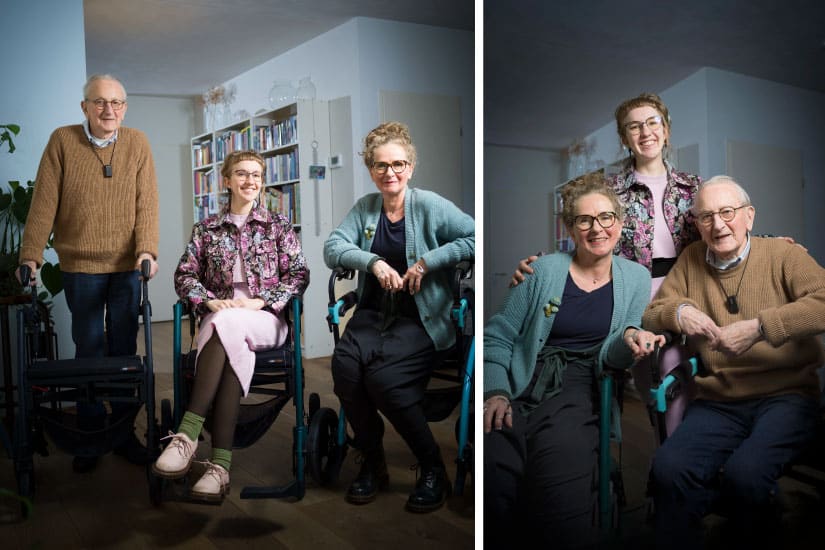A quarter of all people have a disability, but in the Kits/De Winter family, that percentage is much higher. For grandfather Jan Kits (85), daughter Helene de Winter (59), and granddaughter Maartje Reggin-de Winter (29), living with a disability is normal. At Helene’s home they share: “we don’t know differently”.
The disability that Helene and Maartje have is sometimes dismissed as a “women’s problem.” Their illness, the Ehlers-Danlos Syndrome (EDS), is found in men, but it often causes more problems in women. “After my wife passed away, we discovered that she must have had EDS her whole life,” says grandfather Jan Kits. “That’s why I have even more respect for her now than I already did. We regularly traveled to Siberia for evangelism work. It was a tough journey for everyone, but especially for her. She always gritted her teeth and persevered.”
The invisible disability
EDS is a collective term for a group of hereditary connective tissue disorders. This complex syndrome leads to hypermobility and fragile skin, among other things. Patients often suffer from fatigue and pain. It is ironic that these symptoms are often dismissed as “women’s problems” before an EDS diagnosis, according to Helene. “My mother even had her uterus removed in the belief that it would solve the ‘women’s problems’.”
Her mother never received a correct diagnosis. Helene did, but not until she was middle aged. “When I was young and started experiencing symptoms, you couldn’t just search anything on the internet. I was in the dark about my symptoms for a long time.” Maartje was “fortunately” diagnosed at the age of 26. “Fortunately” because this recognition gives her the right to adjustments and facilities for the limitations she had already been experiencing for a long time.
“She had all kinds of recognizable symptoms as a child,” recalls mother Helene. “Extreme growing pains, for example. Or pain when she combed her hair. It was all too familiar to me. In hindsight I should have run to the doctor. But in practice, with these kinds of complaints you are often dismissed as a hypochondriac or whiner.”
The fact that their disability is invisible sometimes makes their limitations even more difficult, because they are therefore not taken into account. Helene has needed her walker when she leaves the house in recent years. “I notice that when my disability is visible, people are more helpful.”
Maartje is annoyed that society is not equally accessible to everyone. “I sometimes don’t take my walker with me, because otherwise I have to take a big detour from my home to work. That bothers me a lot. Everyone in society is entitled to the same easy access to public facilities.”
The Rollz Motion rollator
Maartje, the youngest in the family, was the first to discover the convenience of a rollator. “After me, the older members of the family also started using the Rollz,” she laughs. Her grandfather Jan, who has an artificial shoulder and heart problems, discovered its convenience during a family weekend and was immediately sold. The advantage of their Rollz Motion rollator is that it can be converted into a wheelchair with just a few clicks. And soon, the Delft-based company will also release an electric version. Helene is looking forward to this, as it will greatly expand her possibilities.
It’s also fun that everyone in the family has their own color of rollator. “Why can’t aids be beautiful?” wonders Helene. “Maartje and I are artists. We love beauty. It’s also nice to receive compliments about your rollator. It makes you realize that it’s okay to use a rollator.” For the same reason, Maartje still fantasizes about decorating her compression stockings. “When I arrived at art school wearing compression stockings, we immediately started thinking about how we could make them more beautiful. We came up with the idea of printing tattoos on them using a silk screen technique, which makes the stockings look much cooler.”
Acceptance in the workplace remains difficult. As all three have experienced, as a person with a chronic disability, you have to be willing to stand up for yourself with your employer. In 2016, the UN Convention on the Rights of Persons with Disabilities was ratified, but implementation and compliance continue to lag behind, according to Maartje: “If you can prove that you are entitled to something, it is often easier to arrange. But you have to get everything started yourself.”
Maartje thinks that better education for employers about the available facilities could help. “There are subsidies available for adaptations, but many employers are not aware of this. It’s a shame because people with disabilities often add something to a company. They have a different perspective, above-average perseverance, and are often more resourceful. This makes a company better.”
Source: Rabo &Co magazine
Text: Marijn Kramp
Photographer: Merlijn Doomernik
